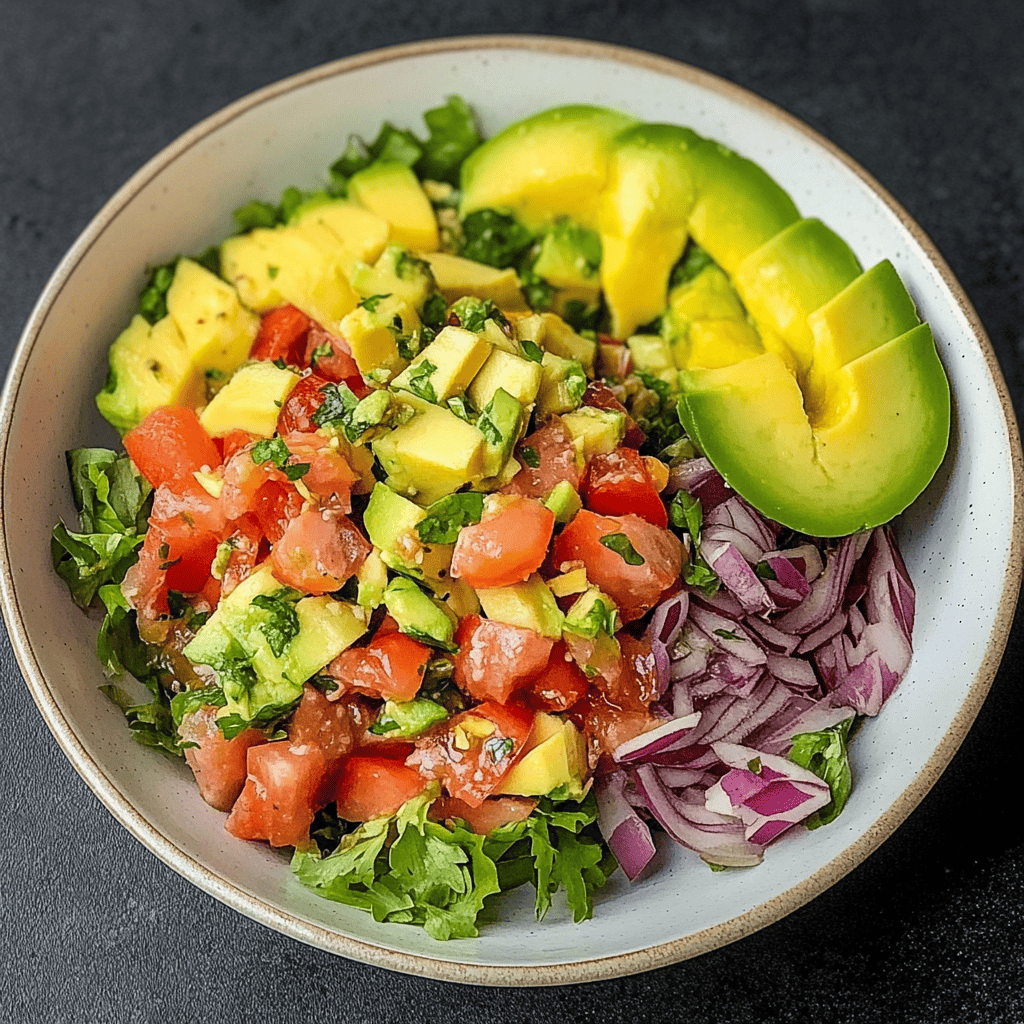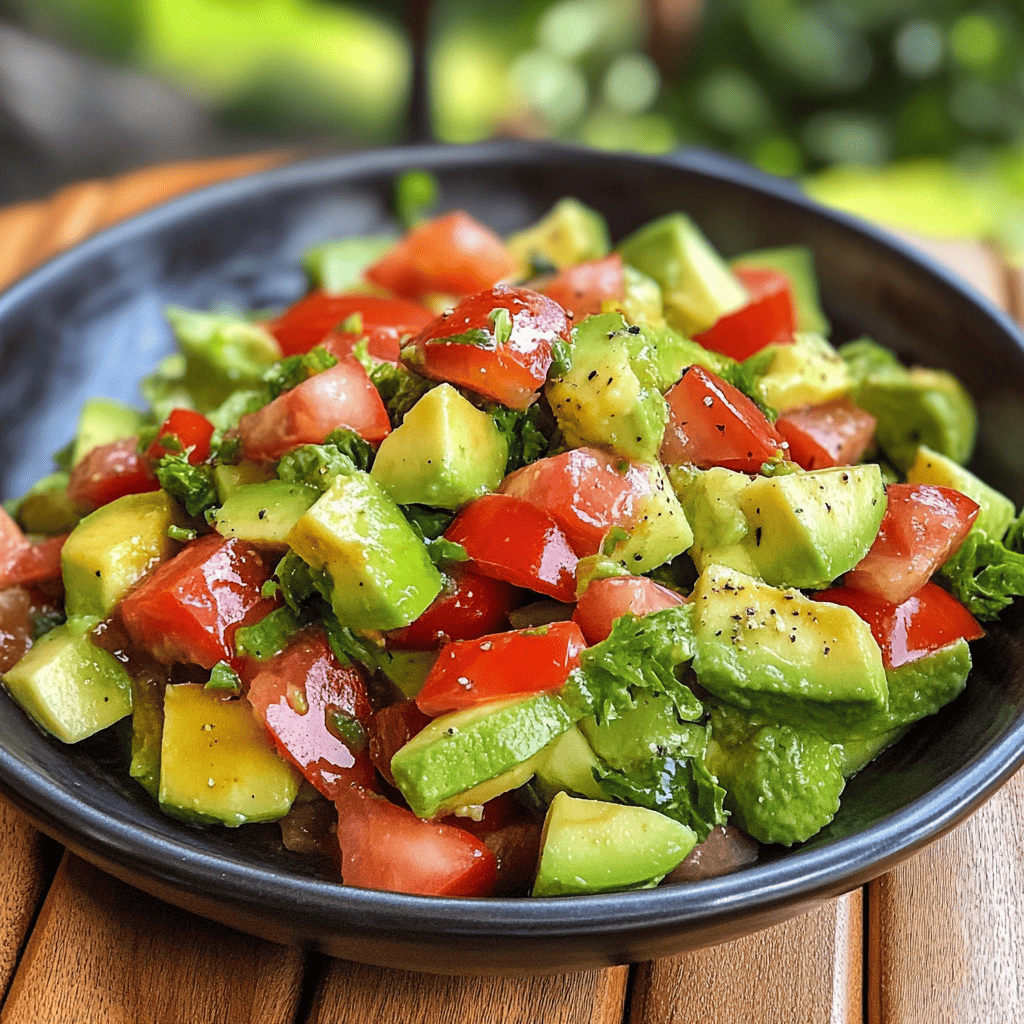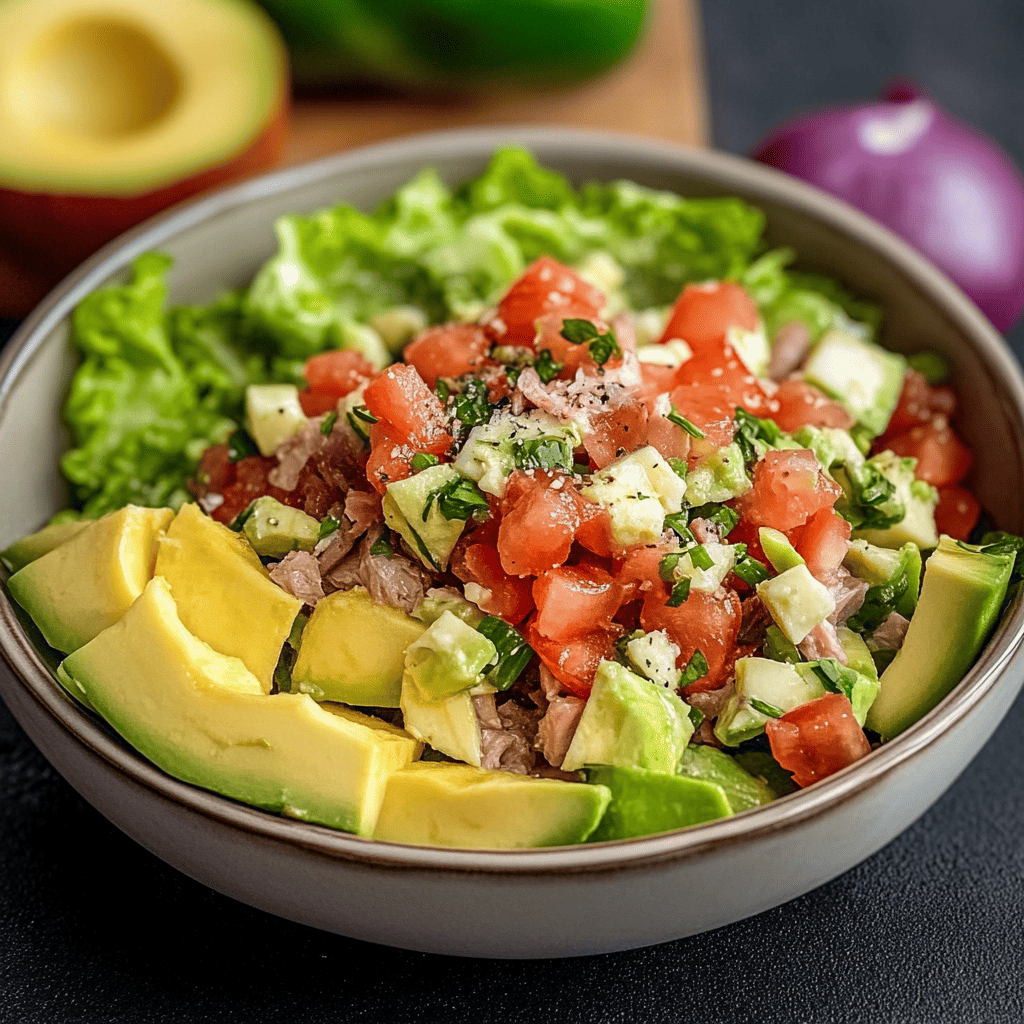Tuna, Lettuce, and Avocado Salad: Freshness, Protein, and Flavor in Every Bite
Introduction: A Versatile and Healthy Classic
Tuna, Lettuce, and Avocado Salad is an iconic dish that has gained global popularity thanks to its combination of nutritious ingredients, its ease of preparation, and its delicious flavor profile. It’s a perfect option for a light lunch, a quick dinner, or a fresh side dish. This salad is not only a feast for the palate but also for the eyes, with its vibrant green colors from the avocado and lettuce, the deep red of the tomato and red onion, and the pink of the tuna. Its versatility allows it to be adapted to different tastes and diets, making it a staple in healthy cooking. Discover all the secrets of this preparation that you’ll love for its freshness and benefits!
Detailed History in Spanish: From the Sea to the World’s Table
The history of “Tuna, Lettuce, and Avocado Salad” is the confluence of several culinary elements and the evolution of eating habits, especially the search for quick, nutritious, and complete meals. Although it doesn’t have a single, specific origin, its popularity has been consolidated in the 20th century, driven by the convenience of canned ingredients and growing health awareness.
Canned Tuna: A Revolutionary Invention: Tuna, a large fish, has been part of the human diet since ancient times, especially in coastal regions. However, its widespread availability and role as a base for many salads is due to the invention of canned tuna in the early 20th century. The first tuna canneries emerged in California in the early 1900s. Canned tuna, being an inexpensive, shelf-stable, and ready-to-use source of protein, quickly became a staple food in many households, especially in the United States. Its popularity grew during the World Wars as a source of protein for soldiers.
Traditional Tuna Salad: The classic tuna salad, often prepared with mayonnaise, celery, and onion, became very popular in the first half of the 20th century, especially in American culture. It was served in sandwiches, on crackers, or stuffed with tomatoes. This base laid the groundwork for later variations.
The Avocado: A Fruit with a Thousand-Year History: The avocado is native to Mexico and Central America, where it has been cultivated and consumed for thousands of years. The Aztecs called it “ahuacatl.” It was introduced to Europe in the 16th century, but didn’t become popular in the United States and other parts of the world until the 20th century. Its creamy texture and healthy fats made it a valued ingredient, especially with the rise of nutrition awareness.
Lettuce and Salads as a Main Course: Lettuce is one of the oldest vegetables cultivated by humans. Salads, in their concept of a mixture of raw vegetables, have existed for centuries. However, the idea of the salad as a complete main course, with protein and fat, became popular in the 20th century, coinciding with the search for lighter meals and the development of refrigeration to keep produce fresh.
The Fusion of Ingredients: The combination of tuna with fresh vegetables like lettuce, tomato, and onion is a natural fit. The addition of avocado, cilantro, and lemon juice is an evolution that reflects the influence of Latin and Mediterranean cuisine, where these ingredients are essential. The avocado provides a creaminess and richness that traditional mayonnaise offered, but with a healthier fat profile. The cilantro and lemon add a touch of freshness and acidity that elevates the flavor.
Boiled Egg: Adding boiled eggs to salads is a common practice in many cuisines, providing additional protein and a different texture. The “Salade Niçoise,” a classic French salad, is an example of how tuna, egg, and vegetables combine harmoniously.
In short, “Tuna, Lettuce, and Avocado Salad” is a dish that evolved from the availability of canned tuna and the growing appreciation for fresh, healthy ingredients. It’s an example of how global cuisines merge to create dishes that are simultaneously convenient, nutritious, and delicious.
More Historical Detail: Healthy Gastronomy and “Healthy Fast Food”
Delving a little deeper into the history and cultural significance of the “Tuna, Lettuce, and Avocado Salad,” we can highlight:
- The Influence of the Mediterranean and Low-Carb Diet: Although the original tuna salad was often associated with mayonnaise and creamy dressings, the version pictured, with avocado and no visible mayonnaise (although it could be hidden), aligns with the growing popularity of the Mediterranean diet and low-carb or ketogenic (keto) diets. In these diets, the healthy fats from avocado and the protein from tuna are highly valued, and fresh vegetables are essential. The absence of heavy dressings and the prominence of natural ingredients are key.
- Bowl Food and Modern Convenience: This dish is presented in a bowl, a format that has gained immense popularity in modern cuisine. Bowl food is characterized as a complete and balanced meal served in a single container, easy to eat on the go or as a meal prep option. This salad is a perfect example of how ingredients can be combined in an aesthetically pleasing and functional way in a single bowl.
- The Collaboration of Textures and Flavors: Tuna and avocado salad is a masterful example of how combining simple textures and flavors creates a rich culinary experience. The contrast between the creaminess of the avocado, the crunchiness of the tuna, the crunch of the lettuce and onion, and the smoothness of the tomato, along with the freshness of the cilantro and the acidity of the lemon, makes for a dynamic and satisfying dish.
- Tuna: Sustainable Source and Challenges: While tuna has been a boon to the global diet, its massive consumption has raised concerns about the sustainability of tuna stocks and fishing practices. Awareness of these issues has led many consumers to seek out sustainably sourced tuna, which is also part of the evolution of this ingredient in modern gastronomy.
- Salad Personalization: Today, salads have transcended their role as mere side dishes to become highly customizable dishes. Healthy fast-food establishments and restaurants offer the possibility of creating custom salads, where tuna, avocado, and vegetables are premium options. This phenomenon has elevated the status of salads like this one.
This salad reflects contemporary culinary trends that prioritize nutrition, convenience, sustainability, and customization without sacrificing flavor or visual appeal.

Ingredients & Detailed Preparation
Ingredients:
- Canned tuna (in water or oil), drained and flaked: 1-2 cans (approximately 150-200 g)
- Romaine or iceberg lettuce, finely chopped or julienned: 4-5 cups
- Medium red tomato, seeded and diced small: 1 unit
- Red onion, small, finely chopped: ½ unit
- Ripe avocado, cut into 1-1.5 cm cubes: 1-2 pieces
- Fresh cilantro, chopped: 2-3 tablespoons
- Hard-boiled egg, cut in half or quarters: 1-2 pieces (for decoration)
- Lemon slice: 1 unit (for decoration and squeezing)
For the Dressing (simple suggestion, adjustable to taste):
- Extra virgin olive oil: 2-3 tablespoons
- Fresh lemon juice: 1-2 tablespoons
- Salt: To taste
- Freshly ground black pepper: To taste
- Optional: A pinch of cumin or garlic powder (for an extra kick)
Necessary equipment:
- Large serving bowl
- Cutting board and knife
- Small bowl for dressing
- Spoon or fork
- Tuna colander
Detailed Preparation:
- Prepare the lettuce base: Wash and dry the lettuce thoroughly. Chop it finely or cut it into julienne strips. Place the chopped lettuce in the bottom of the large bowl where you will serve the salad.
- Prepare the tuna: Open the can of tuna, drain it thoroughly (pressing to remove excess liquid), and flake it lightly with a fork. Place the flaked tuna in the center of the bowl, on top of the lettuce.
- Prepare the vegetables:
- Wash and chop the tomato into small cubes.
- Peel and finely chop the red onion. If the taste of raw onion is too strong for you, you can soak it in cold water with a little vinegar for 10 minutes, then drain it.
- Add the chopped tomato and chopped red onion over the tuna in the bowl.
- Prepare the avocado: Cut the avocado in half, remove the pit, and scoop out the flesh with a spoon. Cut the avocado into cubes of the desired size. To prevent browning, you can immediately sprinkle it with a few drops of lemon juice. Place the avocado cubes on one side of the bowl, next to the lettuce and tuna.
- Add the cilantro: Wash and finely chop the fresh cilantro. Sprinkle a generous amount of chopped cilantro over the tuna and vegetables.
- Prepare the dressing: In a small bowl, combine the olive oil, lemon juice, salt, and pepper. Mix well with a fork or small whisk until the dressing is emulsified. Taste and adjust the seasoning to your liking. If desired, add a pinch of cumin or garlic powder.
- Assemble and garnish: Pour the dressing over the entire salad, or if you prefer, serve it on the side so everyone can serve themselves. Place the halved (or quartered) hard-boiled egg on the side of the salad and a lemon wedge, as shown in the picture. You can sprinkle a little more chopped cilantro for garnish if desired.
- Serving: Serve the salad immediately to enjoy its freshness.
Estimated Preparation Time
- Preparing ingredients (chopping, cutting, draining): 10-15 minutes (if the egg is already cooked)
- Dressing preparation: 2-3 minutes
- Assembly: 2-3 minutes
- Total time: Approximately 15-20 minutes (plus egg cooking time if not set).
Additional Tips
- Quality of ingredients: Use good quality tuna (albacore or light tuna), preferably in olive oil, if you’re not worried about the extra calories, as the flavor is superior. Drain well.
- Perfect Avocado: Make sure the avocado is ripe but firm so the cubes hold their shape.
- Vegetable Variations: You can add other vegetables such as chopped cucumber, sweetcorn, black olives, chopped bell peppers, or grated carrots for added variety and nutrients.
- Additional Protein: In addition to the boiled egg, you can add cooked chickpeas or black beans for extra fiber and plant-based protein.
- Add some spice: If you like it spicy, add some thinly sliced jalapeños or a pinch of chili flakes to the dressing.
- For a more complete meal: Serve the salad with whole-wheat toast, pita bread, or on a bed of cooked quinoa.
- Alternative dressing: You can use a yogurt and dill dressing for a creamier option, or a balsamic vinaigrette for something more tangy.

Frequently Asked Questions
- Can I use another type of fish? Yes, canned salmon or even shredded chicken are good alternatives if you don’t like tuna.
- How to prevent avocado from browning? Sprinkling diced avocados with lemon juice immediately after cutting them helps prevent browning. Mixing them with the other ingredients and the dressing also helps.
- Can it be prepared in advance? It’s best to assemble the salad just before serving, especially the avocado. You can pre-chop the vegetables and drain the tuna, and store the dressing separately.
- How many hard-boiled eggs should I use? One egg per serving is a good amount, but you can adjust based on your preferences or protein needs.
- Is it keto-friendly? Yes, this salad is naturally low in carbs and high in healthy fats and protein, making it ideal for a keto diet.
Texture and Flavor
The texture of this salad is a delight of contrasts. The lettuce base provides a fresh, light crunch. The diced avocado offers a smooth creaminess and a touch of creaminess. The flaked tuna has a tender, slightly fibrous texture. The red onion adds a crisp crunch and a light heat, while the tomato contributes a juicy smoothness. The chopped cilantro adds a herbaceous freshness. Finally, the boiled egg provides a firm texture and a familiar flavor.
The flavor is a symphony of freshness, salty and slightly acidic. The tuna brings the umami flavor of the sea. The avocado offers a subtle, slightly sweet richness. The lettuce and tomato refresh the palate. The red onion introduces a touch of spice and acidity. Cilantro is key to the fresh, aromatic profile. The lemon and olive oil dressing unites all the flavors, providing a vibrant acidity that enhances each ingredient. It’s a clean, balanced, and very satisfying flavor.
Consumer Context
Tuna, Lettuce and Avocado Salad is ideal for:
- Quick lunch: It’s a complete and nutritious meal to take along or prepare at home.
- Light dinner: Perfect when you’re looking for something quick and healthy at night.
- Post-workout meal: Rich in protein and healthy fats for muscle recovery.
- Picnics and barbecues: A fresh and easy-to-transport option.
- Healthy Diet: Fits perfectly into weight control, ketogenic, or low-carb diets.
Visual Aspect
The dish is visually striking and vibrant, as shown in the image. The base of finely shredded lettuce creates a light green canvas. On top of it, the ingredients are presented in an orderly and attractive manner: intense light green avocado cubes occupy the left half of the bowl, looking fresh and creamy. The grayish-pink flaked tuna is piled in the center, dotted with red chunks of tomato and purple cubes of red onion, with green splashes of fresh cilantro. On top, two hard-boiled egg halves, with their bright yellow yolks, and a vibrant yellow lemon wedge add the final touch of color and freshness. The presentation in a white bowl against a dark background enhances the dish’s color palette, inviting you to try it immediately.
Curiosities
- Avocado: Fruit or Vegetable? Botanically, avocado is a fruit (a single-seeded berry), but nutritionally, it’s considered a fat and is used culinary-wise as a vegetable.
- Benefits of tuna: Tuna is an excellent source of high-quality protein and omega-3 fatty acids, essential for cardiovascular and brain health.
- Lettuce: Although it is perceived as “water,” lettuce provides vitamins, minerals, and fiber, as well as volume without many calories.
Nutritional Value (Estimated per Serving)
Please note that these values are approximate and may vary significantly depending on the serving size, the type of tuna (in water or oil), and the amount of dressing. For a large serving (approximately 300-400g):
- Calories: 350-550 kcal (depending on the tuna and the amount of avocado/dressing)
- Protein: 25-35 g (from tuna and egg)
- Fats: 20-40 g (mainly from avocado and olive oil)
- Saturated fat: 3-7 g
- Unsaturated fats: 15-30 g
- Carbohydrates: 10-15 g (from vegetables)
- Sugars: 3-5 g (natural from vegetables)
- Fiber: 7-10 g (from vegetables and avocado)
- Sodium: Variable (from canned tuna and added salt)
- Vitamins and minerals: Vitamin K, Vitamin C, Folate, Potassium, Vitamin B6, Vitamin D (from tuna), Omega-3 (from tuna and avocado).
Additional Benefits and Interesting Facts
- Heart Health: The omega-3 fatty acids in tuna and avocado are beneficial for cardiovascular health.
- Antioxidants: Fresh vegetables provide a large amount of antioxidants that protect the body’s cells.
- Weight control: The combination of protein, healthy fats, and fiber helps promote satiety, which can contribute to weight control.
- Hydration: Lettuce and tomatoes have a high water content, contributing to hydration.
- Nutritional Versatility: Easily adapts to a variety of dietary needs, being naturally gluten-free and, with the right dressing, low in carbohydrates.
Other Information
- Storage: This salad is best prepared and eaten fresh. If you have leftover ingredients, store them separately in airtight containers in the refrigerator. Sliced avocado can oxidize quickly, so it’s best to slice it just before serving or sprinkle it generously with lemon.
- Pairing: Pairs well with a glass of light, dry white wine, such as a Sauvignon Blanc or Albariño, or with a light, refreshing beer.

Conclusion: A Feast of Freshness and Nutrition in Every Bite
Tuna, Lettuce, and Avocado Salad is a clear example of how a meal can be delicious, easy to prepare, and exceptionally nutritious all at the same time. It’s a dish that has earned its place on tables around the world thanks to its balance of flavors, textures, and health benefits. Perfect for any time you’re looking for a light yet filling meal, this salad is an option that will always leave you feeling satisfied and revitalized. Go ahead and prepare it and enjoy this explosion of freshness and well-being on your table!

